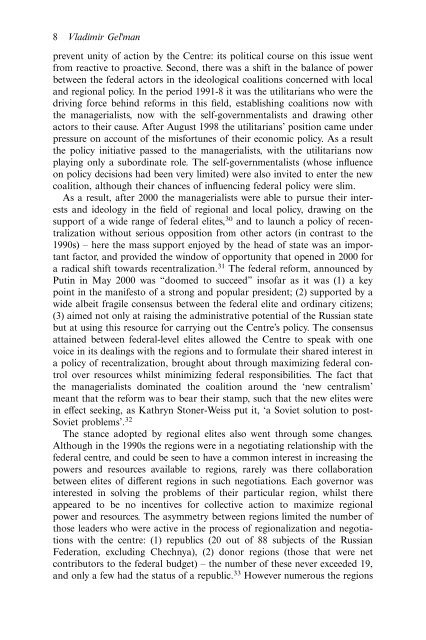Federalism and Local Politics in Russia
Federalism and Local Politics in Russia
Federalism and Local Politics in Russia
Create successful ePaper yourself
Turn your PDF publications into a flip-book with our unique Google optimized e-Paper software.
8 Vladimir Gel'manprevent unity of action by the Centre: its political course on this issue wentfrom reactive to proactive. Second, there was a shift <strong>in</strong> the balance of powerbetween the federal actors <strong>in</strong> the ideological coalitions concerned with local<strong>and</strong> regional policy. In the period 1991-8 it was the utilitarians who were thedriv<strong>in</strong>g force beh<strong>in</strong>d reforms <strong>in</strong> this field, establish<strong>in</strong>g coalitions now withthe managerialists, now with the self-governmentalists <strong>and</strong> draw<strong>in</strong>g otheractors to their cause. After August 1998 the utilitarians’ position came underpressure on account of the misfortunes of their economic policy. As a resultthe policy <strong>in</strong>itiative passed to the managerialists, with the utilitarians nowplay<strong>in</strong>g only a subord<strong>in</strong>ate role. The self-governmentalists (whose <strong>in</strong>fluenceon policy decisions had been very limited) were also <strong>in</strong>vited to enter the newcoalition, although their chances of <strong>in</strong>fluenc<strong>in</strong>g federal policy were slim.As a result, after 2000 the managerialists were able to pursue their <strong>in</strong>terests<strong>and</strong> ideology <strong>in</strong> the field of regional <strong>and</strong> local policy, draw<strong>in</strong>g on thesupport of a wide range of federal elites, 30 <strong>and</strong> to launch a policy of recentralizationwithout serious opposition from other actors (<strong>in</strong> contrast to the1990s) – here the mass support enjoyed by the head of state was an importantfactor, <strong>and</strong> provided the w<strong>in</strong>dow of opportunity that opened <strong>in</strong> 2000 fora radical shift towards recentralization. 31 The federal reform, announced byPut<strong>in</strong> <strong>in</strong> May 2000 was “doomed to succeed” <strong>in</strong>sofar as it was (1) a keypo<strong>in</strong>t <strong>in</strong> the manifesto of a strong <strong>and</strong> popular president; (2) supported by awide albeit fragile consensus between the federal elite <strong>and</strong> ord<strong>in</strong>ary citizens;(3) aimed not only at rais<strong>in</strong>g the adm<strong>in</strong>istrative potential of the <strong>Russia</strong>n statebut at us<strong>in</strong>g this resource for carry<strong>in</strong>g out the Centre’s policy. The consensusatta<strong>in</strong>ed between federal-level elites allowed the Centre to speak with onevoice <strong>in</strong> its deal<strong>in</strong>gs with the regions <strong>and</strong> to formulate their shared <strong>in</strong>terest <strong>in</strong>a policy of recentralization, brought about through maximiz<strong>in</strong>g federal controlover resources whilst m<strong>in</strong>imiz<strong>in</strong>g federal responsibilities. The fact thatthe managerialists dom<strong>in</strong>ated the coalition around the ‘new centralism’meant that the reform was to bear their stamp, such that the new elites were<strong>in</strong> effect seek<strong>in</strong>g, as Kathryn Stoner-Weiss put it, ‘a Soviet solution to post-Soviet problems’. 32The stance adopted by regional elites also went through some changes.Although <strong>in</strong> the 1990s the regions were <strong>in</strong> a negotiat<strong>in</strong>g relationship with thefederal centre, <strong>and</strong> could be seen to have a common <strong>in</strong>terest <strong>in</strong> <strong>in</strong>creas<strong>in</strong>g thepowers <strong>and</strong> resources available to regions, rarely was there collaborationbetween elites of different regions <strong>in</strong> such negotiations. Each governor was<strong>in</strong>terested <strong>in</strong> solv<strong>in</strong>g the problems of their particular region, whilst thereappeared to be no <strong>in</strong>centives for collective action to maximize regionalpower <strong>and</strong> resources. The asymmetry between regions limited the number ofthose leaders who were active <strong>in</strong> the process of regionalization <strong>and</strong> negotiationswith the centre: (1) republics (20 out of 88 subjects of the <strong>Russia</strong>nFederation, exclud<strong>in</strong>g Chechnya), (2) donor regions (those that were netcontributors to the federal budget) – the number of these never exceeded 19,<strong>and</strong> only a few had the status of a republic. 33 However numerous the regions
















